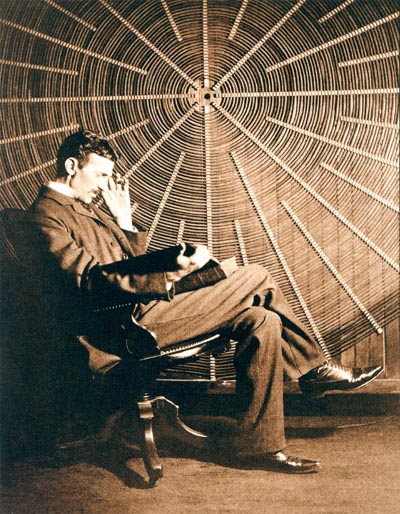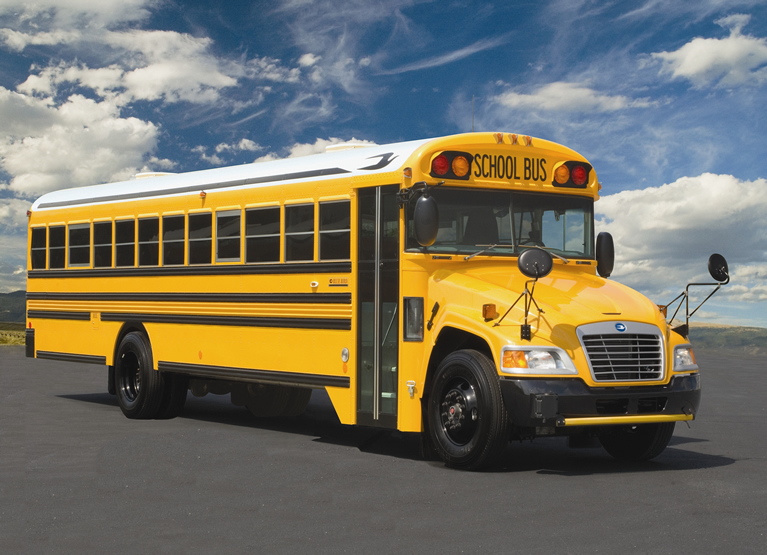The original question was: Is it possible that, when more efficient methods of harnessing light energy are established, light could be used as a means to transfer massive amounts of energy (for instance, enough to power a city) without physical wires? What are some of the obstacles that would prevent such energy transfer?
Physicist: It depends on how liberal your definition of “light” is.
Way back in the day Tesla did a whole bunch of research into exactly what you’re talking about: wireless transmission of power. One application he envisioned (and this is one of the draw backs) was an honest-to-god death ray.

Nikola Tesla set the bar pretty high for every mad scientists that followed. Here he's showing off one of his more terrifying inventions: the desk chair.
Didn’t work. Not even close. Ironically, Tesla’s grandiose claims and electrically-based publicity stunts have made him a magnet for “alternative science“.
There is some active research in using microwaves and magnetic coils to transfer energy, but so far the results have been pretty underwhelming. Technically, all transformers are wireless. They use a coil to generate a changing magnetic field, and that changing magnetic field carries the energy to another coil that turns it back into electricity (at a different voltage).

Transformers (the can) are used to "step down" voltage from power lines so that the electricity in our homes doesn't kill the hell out of us. In the process, it efficiently and wirelessly transfers energy over distances as large as several millimeters. The energy takes the form of magnetic waves, which is technically light (technically).
What you’d really like is a beam of energy. Low frequency waves tend to spread out a lot (which is part of why transformers are so compact), and higher frequency waves (microwaves and radar, that sort of thing) tend to interact with matter other than the specially constructed receivers (i.e., frying stuff in the beam).
You also have to be extremely careful about how the receiver is built. For example, when you point a telescope at the sun you have to be very sure that the lenses are clean. A tiny bit of grit can absorb light, heat up, blacken the lens, making it absorb light, making it heat up and blacken more…
Similar things (melting) happen with high-energy, high-frequency receivers, which is profoundly unfortunate, since without high-frequencies it’s basically impossible to aim your beam.
A laser capable of powering Los Angeles (about 6 gigawatts) can melt a school bus in a little under one second (make a note, that was the least useful statistic you’ll read this month). So, you need to make sure that whatever system you have for catching the beam had better be really efficient. Even at 99% efficiency you’d need a huge cooling system (enough to keep a bus from melting in about a minute). The whole set up is just an accident waiting to happen.
For comparison, the most efficient solar panels today can convert about 50% of the light that falls on them into electricity. You could use many beams to spread out the heating, but ultimately wires are a pretty good way to go.
On the other hand, a beam would be the easiest way to transfer energy between the ground and space (not that it easy even then).








I recall a patent being filed for an optical magnetron that was supposed to be capable of not only generating light frequency wavelengths, but receiving them and converting them to useable electricity… haven’t heard much more about it though, so would you think there’s a fundamental problem with the design, like your mention of overheating, or just too expensive or advanced for us to currently build at scale?
Are these new charging mats for phones and also the electromagnetic charging points for electric cars that one parks ones car over exactly the thing in question?
Pretty much.
A coil in the mat, and a coil in the phone make up the two coils of a single transformer.
So wires because of the safety and practicality? But it is still possible?
Safety and practicality… It makes me think that you could probably design a bullet catcher to harness and convert kinetic energy into useable electricity… Some of the arguments against it are going to be in the same areas though.
Well there were similar safety concerns around cars as well such as the engine exploding, or a giant mass catching high speed and flying into things. In the end we can see that the gains outweigh the implications of dangerous outcomes and engineering does catch up to provide for some safe guards. It all just takes time and the will of market demand.
yes we all know that wireless power is extremely dangerous here on Earth, but it could have it’s uses for space exploration which is why I’m curious.
Technically we can send power with light though since we can create light with electricity and convert it back into power with a solar panel. It’s just not very efficient.